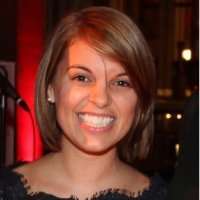A happy few: that was how Gabriel Kahane referred to his cohorts on stage at the Galapagos Art Space. But there was more than met the eye to Sunday night’s performance.
The curtain opened to reveal the stage at the Galapagos Art Space, and there sat the Orpheus Chamber Orchestra, without a conductor. Truthfully, the effect was strange at first. But all reservations were immediately rescinded with the very first movement from Paul Hindemith’s Kammermusik no. 1, Op.24 no.1. Performed at a rapid pace, it is also wildly dissonant. Written for 12 soloists - flute, clarinet, bassoon, trumpet, piano, strings, xylophone, even an accordion and a slide whistle - this piece goes on to include a dizzying march, a minimalist, pastoral quartet, and a whirlwind of an ending. In the fourth and final movement, a maniacal, carnival-like theme is repeated in all twelve major keys, the rhythm is relentless and the string section hardly had a moment to breathe. Exciting both to watch and to hear, it was incredible to see Orpheus illuminate the sparkling instrumentation in the piece and put on a performance that was (seemingly) effortless.
Offering up a slight change of pace, Gabriel Kahane, Orpheus’ new composer-in-residence, introduced a work for 16 soloists, Orinono Sketches. This is Kahane’s musical translation of his grandmother’s diaries from her voyage in exile, from Germany to Havana, then New Orleans, and finally Los Angeles. Soft and melancholy where Hindemith was jaunty and fierce, the two pieces were nevertheless tied by their émigré connection: both Hindemith and Kahane’s grandmother sought refuge from Nazi-occupied Germany on American soil.
It was evident from the start that Kahane had a keen ear for instrumentation. Opening with an anxious three-against-two rhythm, Orinoco Sketches immediately conveyed a sense of urgency, a feeling akin to being afraid in exile and feeling compelled to remain constantly in motion. But the mood changed towards the middle of the piece; the tempo slowed and the strings played such long, broad strokes, it felt like a wave of sound washing over the audience. A nice touch as Kahane sang, ‘I can see Havana on the horizon'. At that moment, we could all envision his grandmother on the bow of a boat, looking out across the sea towards Cuba’s emerging coastline.
Continuing with his grandmother’s story, Orinoco Sketches took on an Afro-Cuban feel, evoking images of a bustling city street, either in Havana or New Orleans. But then Kahane moved from the piano to the guitar and suddenly, we were on a stretch of road in the California dessert. It was here, in this lazy, folksy, whimsical place that Kahane felt most at home. A fitting end when the last lyrics rang out: ‘Do I call it my home? Do I feel it at all?’
Following, Kahane and select members of the Orpheus Chamber Orchestra performed selections from Kahane’s newly released album, Where are the Arms. Kahane’s keen sense of colour and instrumentation pervaded, resulting in a strange yet wonderful mix of classical, folk and pop music. Playing on both piano and guitar, singing along with the Orchestra and conducting each of the eleven songs, Kahane proved that his rare depth of musicality is not strictly limited to classical music, but translates into other styles as well.
With a look to the past, Orpheus kept us firmly planted in the present, breathing fresh air into a sometimes-stagnant musical culture. Meanwhile Kahane, although he presented brand new music, left audiences feeling warmed with nostalgia for fragments of distant memories and intimate stories shared throughout the performance. Sitting in the darkened hall at Galapagos Art Space, the effect was enchanting.


